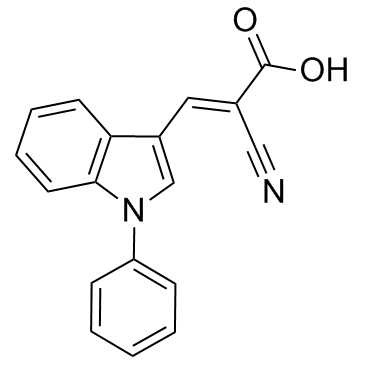UK-5099

UK-5099 structure
|
Common Name | UK-5099 | ||
|---|---|---|---|---|
| CAS Number | 56396-35-1 | Molecular Weight | 288.300 | |
| Density | 1.2±0.1 g/cm3 | Boiling Point | 448.6±45.0 °C at 760 mmHg | |
| Molecular Formula | C18H12N2O2 | Melting Point | N/A | |
| MSDS | Chinese USA | Flash Point | 225.1±28.7 °C | |
|
Whole cell Cl- currents in human neutrophils induced by cell swelling.
Am. J. Physiol. 265(1 Pt 1) , C156-65, (1993) The properties of the conductive Cl- transport pathway underlying regulatory volume decrease (RVD) in human neutrophils were investigated using the whole cell patch-clamp technique. Cell swelling was induced during whole cell recordings by making the patch pi... |
|
|
Mitochondrial metabolism of pyruvate is essential for regulating glucose-stimulated insulin secretion.
J. Biol. Chem. 289(19) , 13335-46, (2014) It is well known that mitochondrial metabolism of pyruvate is critical for insulin secretion; however, we know little about how pyruvate is transported into mitochondria in β-cells. Part of the reason for this lack of knowledge is that the carrier gene was on... |
|
|
Interleukin-1beta secretion is impaired by inhibitors of the Atp binding cassette transporter, ABC1.
Blood 90(8) , 2911-5, (1997) The production of interleukin-1beta (IL-1beta), a powerful mediator of inflammation, is tightly regulated at several levels. However, in some pathologic conditions, a pharmacologic treatment is required to control the toxicity of excessive extracellular IL-1b... |
|
|
Thiazolidinediones are acute, specific inhibitors of the mitochondrial pyruvate carrier.
Proc. Natl. Acad. Sci. U. S. A. 110(14) , 5422-7, (2013) Facilitated pyruvate transport across the mitochondrial inner membrane is a critical step in carbohydrate, amino acid, and lipid metabolism. We report that clinically relevant concentrations of thiazolidinediones (TZDs), a widely used class of insulin sensiti... |
|
|
A re-evaluation of the role of mitochondrial pyruvate transport in the hormonal control of rat liver mitochondrial pyruvate metabolism.
Biochem. J. 223(3) , 677-85, (1984) The inhibitor of mitochondrial pyruvate transport alpha-cyano-beta-(1-phenylindol-3-yl)-acrylate was used to inhibit progressively pyruvate carboxylation by liver mitochondria from control and glucagon-treated rats. The data showed that, contrary to our previ... |
|
|
The concentration of the mitochondrial pyruvate carrier in rat liver and heart mitochondria determined with alpha-cyano-beta-(1-phenylindol-3-yl)acrylate.
Biochem. J. 223(3) , 673-6, (1984) alpha-Cyano-beta-(1-phenylindol-3-yl)acrylate inhibited pyruvate transport into both liver and heart mitochondria approximately linearly with respect to its concentration until 65% inhibition was achieved. The extent of inhibition was dependent on the mitocho... |
|
|
Pyruvate transport by thermogenic-tissue mitochondria.
Biochem. J. 247(2) , 441-7, (1987) 1. Mitochondria isolated from the thermogenic spadices of Arum maculatum and Sauromatum guttatum plants oxidized external NADH, succinate, citrate, malate, 2-oxoglutarate and pyruvate without the need to add exogenous cofactors. 2. Oxidation of substrates was... |
|
|
Tenidap inhibits replication of the human immunodeficiency virus-1 in cultured cells.
J. Acquir. Immune Defic. Syndr. Hum. Retrovirol. 14(1) , 13-7, (1997) Interleukin-6 (IL-6) may be important in the pathogenesis of HIV-1 because of its ability to induce HIV-1 expression in infected cells in vitro. Tenidap, a structurally and functionally novel antirheumatic drug affecting diverse biologic processes, has been s... |